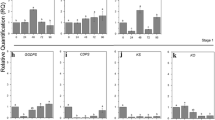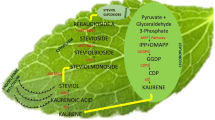Abstract
The optimal timing of elicitation was determined for the production of benzophenanthridine alkaloids (BPAs) by Eschscholtzia californica cell culture. Upon elicitation, 7-day old cells produced more alkaloids than 14-day old cells (5.1 times for sanguinarine and 2.7 times for dihydrosanguinarine). We presumed that these alkaloids are growth-rate-associated secondary metabolites in E. californica cell culture. Although the specific productivity of alkaloids were higher in 7-day old culture, the total cell mass of 7-day old culture was about half that of 14-day old culture. In order to increase the overall productivity, sucrose was added to the 14-day old culture before the addition of elicitor. By this way, cells in the stationary phase (14-day old culture) could be switched to the cells in the logarithmic growth phase (similar to 7-day old culture). Total production of alkaloids was increased by adding sucrose; especially the production of sanguinarine was increased as high as 5.7 times of the control. To find out the protein level changed by the elicitation, proteins extracted from whole cell were separated by using two-dimensional gel electrophoresis. The patterns of the gels were different and little correlation among the proteins could be observed. And Western blotting was employed to check the expression level of selected five enzymes, these enzymes believed to be involved in BPAs production, resulting in up-regulated with elicitor addition.
Similar content being viewed by others
Abbreviations
- 4′OMT:
-
3-hydroxy-N-methylcoclaurine 4-O-methyltransferase
- 6OMT:
-
norcoclaurine 6-O-methyltransferase
- BPA:
-
benzophenanthridine alkaloid
- BBE:
-
berbeine bridge enzyme
- CYP80B1:
-
N-methylcoclaurine 3′-hydroxylase
- DHBO:
-
dihydrobenzophenanthridine oxidase
- DBPA:
-
Dihydroform benzophenanthridine alkaloid
References
Ayabe S-I, Iida K, Furuya T (1986) Stress-induced formation of echinatin and a metabolite, 5′-prenyl-licodione, in cultured Glycyrrhiza echinata cells. Phytochemistry 25:2803–2806
Blechert S, Brodschelm W, Hoelder S, Kammerer L, Kutchan TM, Mueller MJ, Xia Z-Q, Zenk MH (1995) The octadecanoic pathway: signal molecules for the regulation of secondary pathways. Proc Natl Acad Sci USA 92:4099–4105
Bradford MM (1976) A rapid and sensitive method for the quantitation of microgram quantities of protein utilizing the principle of protein-dye binding. Anal Biochem 72:248–254
Byun SY, Ryu YW, Kim C, Pedersen H (1992) Elicitation of sanguinarine production in two-phase cultures of Eschscholtzia californica. J Ferment Bioeng 73:380–385
Ellis DD, Zeldin EL, Brodhagen M, Russin WA, McCown BH (1996) Taxol production in nodule cultures of Taxus. J Nat Prod 59:246–250
Facchini PJ, Penzes C, Johnson AG, Bull D (1996) Molecular characterization of berberine bridge enzyme genes from opium poppy. Plant Physiol 112:1669–1677
Funk C, Gugler K, Brodelius P (1987) Increased secondary product formation in plant cell suspension cultures after treatment with a yeast carbohydrate preparation (elicitor). Phytochemistry 26:401–405
Hahn MG, Albersheim P (1978) Host-pathogen interactions. XIV. Isolation and partial characterization of an elicitor from yeast extract. Plant Physiol 62:107– 111
Harkrader RJ, Reinhart PC, Rogers JA, Jones RR, Wylie RE II, Lowe BK, McEvoy RM (1990) The history, chemistry and pharmacokinetics of sanguinaria extract. J Can Dent Assoc 56:7–12
Henzel WJ, Billeci TM, Stults JT, Wong SC, Grimley C, Watanabe C (1993) Identifying proteins from two-dimensional gels by molecular mass searching of peptide fragments in protein sequence databases. PNAS 90:5011–5015
Ignatov A, Neuman MC, Barg R, Krueger RJ, Coscia CJ (1997) Immunoblot analyses of the elicited Sanguinaria canadensis enzyme, dihydrobenzophenanthridine oxidase: evidence for resolution from a polyphenol oxidase isoenzyme. Arch Biochem Biophys 347:208–212
Jacobs DI, Van der Heijden R, Verpoorte R (2000) Proteomics in plant biotechnology and secondary␣metabolism research. Phytochem Anal 11:277–287
Keßmann H, Barz W (1987) Accumulation of isoflavones and pterocarpan phytoalexins in cell suspension cultures of different cultivars of chickpea Cicer arietinum. Plant Cell Rep 6:55–59
Ketchum REB, Gibson DM, Croteau RB, Shuler ML (1999) The kinetics of taxoid accumulation in cell suspension cultures of Taxus following elicitation with methyl jasmonate. Biotechnol Bioeng 62:97–105
Kim SI, Choi HK, Kim JH, Lee HS, Hong SS (2001) Effect of osmotic pressure on paclitaxel production in suspension cell cultures of Taxus chinensis. Enzyme Microb Techn 28:202–209
Laemmli UK (1970) Cleavage of structural proteins during the assembly of the head of bacteriophage T4. Nature (London, United Kingdom) 227:680–685
Lamboursain L, Jolicoeur M (2005) Critical influence of Eschscholzia californica cells nutritional state on secondary metabolite production. Biotechnol Bioeng 91:827–837
Lin M, Campbell JM, Mueller DR, Wirth U (2003) Intact protein analysis by matrix-assisted laser desorption/ionization tandem time-of-flight mass spectrometry. Rapid Commun Mass Spectrom 17:1809–1814
Linden JC, Haigh JR, Mirjalili N, Phisaphalong M (2001) Gas concentration effects on secondary metabolite production by plant cell cultures. Adv Biochem Eng/Biotechnol 72:27–62
Mann M, Pandey A (2001) Use of mass spectrometry-derived data to annotate nucleotide and protein sequence databases. Trends Biochem Sci 26:54–61
Mathesius U, Imin N, Chen H, Djordjevic MA, Weinman JJ, Natera SHA, Morris AC, Kerim T, Paul S, Menzel C, Weiller GF, Rolfe BG (2002) Evaluation of proteome reference maps for cross-species identification of proteins by peptide mass fingerprinting. PROTEOMICS 2:1288–1303
Morishige T, Tsujita T, Yamada Y, Sato F (2000) Molecular characterization of the s-adenosyl-l-methionine:3′-hydroxy-N-methylcoclaurine 4′-O-methyltransferase involved in isoquinoline alkaloid biosynthesis in Coptis japonica. J Biol Chem 275:23398–23405
Panda AK, Mishra S, Bisaria VS (1992) Alkaloid production by plant cell suspension cultures of Holarrhena antidysenterica: I Effect of major nutrients. Biotechnol Bioeng 39:1043–1051
Pauli HH, Kutchan TM (1998) Molecular cloning and functional heterologous expression of two alleles encoding (S) N methylcoclaurine 3′ hydroxylase (CYP80B1), a new methyl jasmonate inducible cytochrome P 450 dependent mono oxygenase of benzylisoquinoline alkaloid biosynthesis. Plant J 13:793–801
Phisalaphong M, Linden JC (1999) Kinetic studies of paclitaxel production by Taxus canadensis cultures in batch and semicontinuous with total cell recycle. Biotechnol Prog 15:1072–1077
Raharjo TJ, Widjaja I, Roytrakul S, Verpoorte R (2004) Comparative proteomics of Cannabis sativa plant tissues. J Biomol Tech 15:97–106
Rose JKC, Bashir S, Giovannoni JJ, Jahn MM, Saravanan RS (2004) Tackling the plant proteome: practical approaches, hurdles and experimental tools. Plant J 39:715–733
Thorne EM, Boulware RT, Harkrader RJ, Southard GL (1986) HPLC analysis of sanguinarine in oral health care products. J Soc Cosmet Chem 37:279–286
Tyler RT, Eilert U, Rijnders COM, Roewer IA, Kurz WGW (1988) Semi-continuous production of sanguinarine and dihydrosanguinarine by Papaver somniferum L cell suspension cultures treated with fungal homogenate. Plant Cell Reports 7:410–413
Vincieri FF, Celli S, Mulinacci N, Speroni E (1988) An approach to the study of the biological activity of Eschscholtzia californica Cham. Pharmacol Res Commun 5(Suppl 20):41–44
Wang C, Wu J, Mei X (2001) Enhancement of taxol production and excretion in Taxus chinensis cell culture by fungal elicitation and medium renewal. Appl Microbiol Biotechnol 55:404–410
Wang HQ, Yu JT, Zhong JJ (1999) Significant improvement of taxane production in suspension cultures of Taxus chinensis by sucrose feeding strategy. Process Biochem 35:479–483
Watson BS, Asirvatham VS, Wang L, Sumner LW (2003) Mapping the Proteome of Barrel Medic (Medicago truncatula). Plant Physiol 131:1104–1123
Yukimune Y, Tabata H, Higashi Y, Hara Y (1996) Methyl jasmonate-induced overproduction of paclitaxel and baccatin III in Taxus cell suspension cultures. Nat Biotech 14:1129–1132
Zhang C-H, Wu J-Y (2003) Ethylene inhibitors enhance elicitor-induced paclitaxel production in suspension cultures of Taxus spp cells. Enzyme Microb Technol 32:71–77
Acknowledgement
This work was financially supported by the KOSEF through the AEBRC at POSTECH.
Author information
Authors and Affiliations
Corresponding author
Rights and permissions
About this article
Cite this article
Park, JJ., Yoon, SY.H., Cho, H.Y. et al. Patterns of protein expression upon adding sugar and elicitor to the cell culture of Eschscholtzia californica . Plant Cell Tiss Organ Cult 86, 257–269 (2006). https://doi.org/10.1007/s11240-006-9115-1
Received:
Accepted:
Published:
Issue Date:
DOI: https://doi.org/10.1007/s11240-006-9115-1




